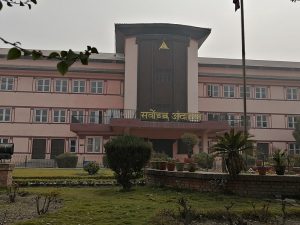Sambridh Ghimire

Yet another crisis has erupted in Himalayan nation of Nepal. Last week, the Supreme Court nullified the appointment of 20 ministers inducted by Prime Minister K.P. Sharma Oli. According to its interim order, the Supreme Court has directed respondents, including the office of the president, not to allow the 20 ministers to administer their office. This comes against the backdrop of a challenge in the Supreme Court to the recent dissolution of the country’s Parliament.
The Supreme Court opined that following the dissolution, according to Article 77(1)(c), the prime minister is ipso facto no longer a member of the House of Representatives. In that case, Article 77(3)(1) applies, which states: “the same Council of Ministers shall continue to act until another Council of Ministers is constituted.” Furthermore, the Supreme court said that the incumbent cabinet would continue with no further expansions in these exceptional circumstances. It also categorically stated that the prime minister had no prima facie authority to expand the cabinet in this situation.
There have been more than four scrimmages between the executive and the judiciary in the past six months. The Supreme Court has time and time again dismissed the executive’s decisions: on the unification of the Unified Marxist-Leninist (UML) and Maoist Center (MC) branches of the Nepal Communist Party, the first dissolution of Parliament, the appointment of non-MPs as ministers, and the Citizenship Amendment Ordinance. All these pronouncements from the Court have gone against the decision of the government or the ruling party, which signifies a deep level of skepticism between the two institutions.
But tension between state institutions is nothing new to Nepal. In 2017, there were similar tensions between the judiciary and executive. The first women chief justice had to face an impeachment motion for her crusade against corruption, as she apparently interfered with the exclusive jurisdiction of the executive and judiciary. Although that was not the only reason for the impeachment, the other state institutions were worried due to the judiciary’s hyper-activism. The Court has also not remained aloof from politics; the most significant blow to the independence of the judiciary was when Khil Raj Regmi was appointed as the caretaker prime minister while simultaneously holding the position of chief justice. This was the most significant instance of collusion of powers, contrary to what was envisioned by the French philosopher Montesquieu in his book “The Spirit of the Laws.”
But the ongoing crises between the executive and judiciary are different from those in the past, due to the very volatile state the country is in at present. There has been a feud in the unified Nepal Communist Party (NCP), which won the elections with an overwhelming majority after a merger between the UML and MC. One of the most powerful prime ministers the nation has ever seen has dissolved Parliament not once but twice. The Supreme Court since bifurcated the NCP into its constituent elements. And an ambitious chief justice with debatable integrity is at the helm of affairs in the judiciary. However, the Court’s recent decisions have been applauded by the opposition, a large section of the intellectuals, civil society members, and the general public.
Other institutions of the state have consistently undermined Nepal’s judiciary. During the rule of the monarchy, the monarch was the head of the state and wielded executive powers, which put the institution of monarchy outside judicial jurisdiction. A similar trend was followed in the years of multiparty democracy, as a culture of undermining the judiciary had been established. The judiciary was also subservient to this idea of executive hegemony and did not pose challenges to the executive.
Moreover, the judiciary aided this system by letting itself become increasingly politicized. Judges in the Supreme Court were appointed according to a quota set aside for the major parties in Parliament. This was in the 2010s when only a few instances of judicial activism could be observed in Nepal. But the honeymoon period was cut short when, in an extra-constitutional arrangement, the judiciary colluded to mock the principle of separation of powers. The hope for an impartial and just judicial system was reinvigorated in 2017 when the judiciary convicted politicians and political appointees. Since then, there has been an underlying conflict about the actual or perceived supremacy of one constitutional institution over the other.
A debate between the institutions is a welcome one, and the judiciary trying to free itself from the clutches of other institutions is more than appreciated. However as the Renaissance giant Leonardo da Vinci stated, “once you have tasted the taste of sky, you will forever look up.” Similarly, the judiciary of Nepal has savored the power of the executive, and one should not be surprised if the Court tries to pursue it again. The circumstances in the nation are seductive enough for the judiciary to be lured to seek power, as following the dissolution of Parliament, there is a political vacuum, and the political actors are constantly engaging in melees between themselves.
Elections have been announced for November 2021. In the unlikely event that Parliament is not restored, a question that is under the exclusive jurisdiction of the judiciary, and if new elections cannot be held in six months from the dissolution, the nation will have to yield to an extra-constitutional solution as the present constitution does not envisage such a situation. Experts have predicted that the third wave of COVID-19 will hit South Asia by September or October, and if that happens, Nepal will not be an exception. With an ambitious chief justice and history as a witness to the kind of extra-constitutional solution that was undertaken in 2013, one can only wonder about the possibilities that Nepal’s future has in store.
No comments:
Post a Comment